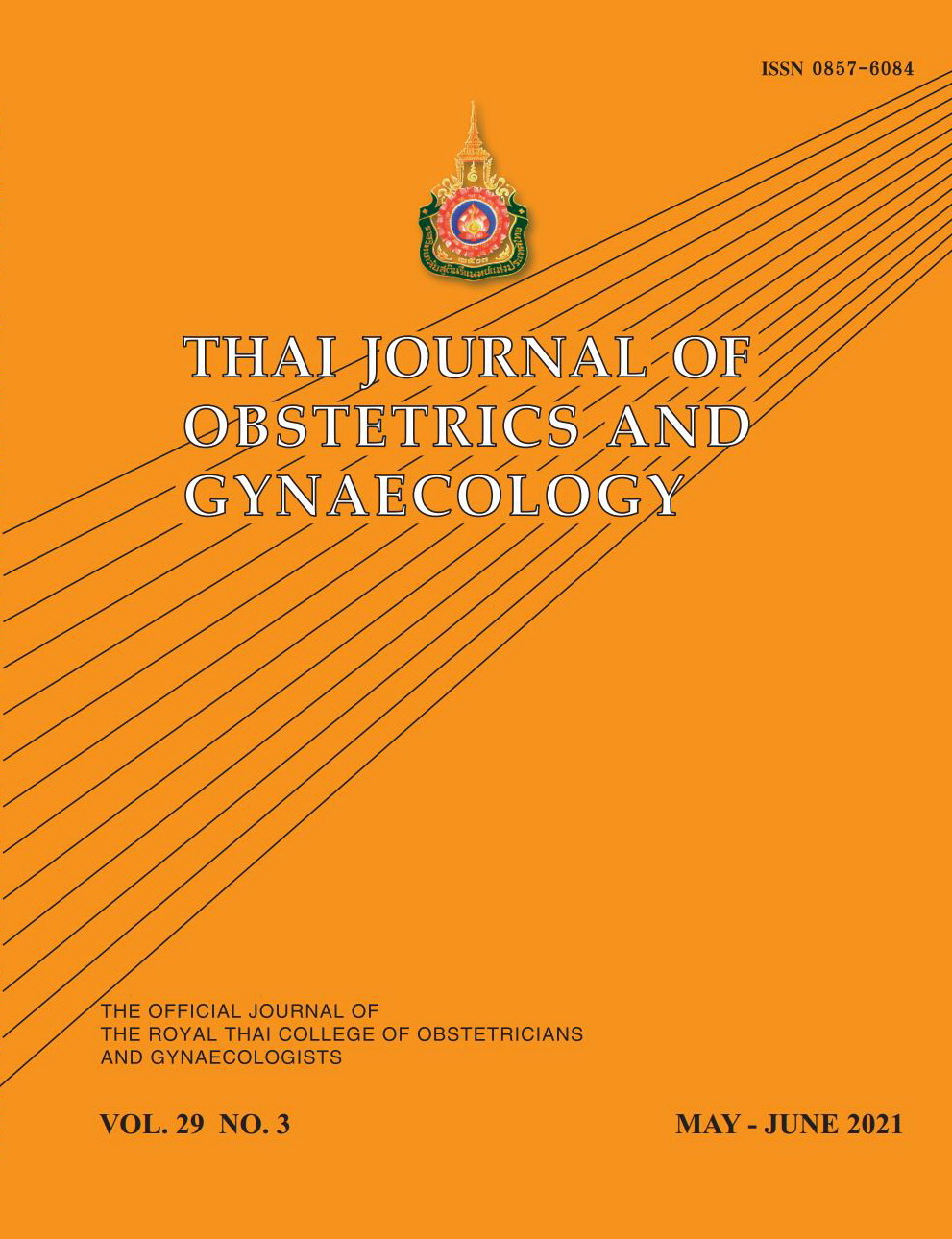Success Rate of Intrauterine Fetal Resuscitation in NICHD Category II Abnormal Fetal Heart rate pattern
Main Article Content
Abstract
Objectives: To evaluate success rate of intrauterine fetal resuscitation in women with abnormal fetal heart rate (FHR) in National Institute of Child Health and Human Development (NICHD) category II and associated factors.
Materials and Methods: A retrospective cohort study was conducted among 296 women with abnormal FHR in NICHD category II during labor and delivery at Siriraj Hospital. Intrauterine fetal resuscitations were provided according to institutional guideline. Success rate was defined as a return of FHR pattern to NICHD category I within 30 minutes. Related data were extracted from medical record, including baseline and obstetric characteristics, characteristics of abnormal FHR and intrauterine resuscitation, and pregnancy outcomes.
Results: Most of abnormal FHR pattern occurred during active phase of labor (60.5%). Common patterns of NICHD category II were prolonged deceleration (34.8%) and recurrent variable deceleration (32.4%). Success rate of intrauterine resuscitation was 52.4%. Success rate significantly increased when abnormal FHR occurred in latent phase (p < 0.001), accompanied with early deceleration (p < 0.001) or minimal FHR variability (p = 0.031). Logistic regression analysis showed that factors independently associated with failure of intrauterine resuscitation were abnormal FHR during active phase (adjusted odds ratio (OR) 2.8, 95% confidence interval (CI) 1.3-6.4, p = 0.01) or deceleration phase (adjusted OR 13.5, 95%CI 5.1-35.7, p < 0.001), abnormal FHR with late deceleration (adjusted OR 3.4, 95%CI 1.2-9.5, p = 0.023) or variable deceleration (adjusted OR 6.3, 95%CI 2.3-16.9, p < 0.001).
Conclusion: Success rate of intrauterine fetal resuscitation in NICHD category II FHR patterns was 52.4%. Factors significantly associated with success rate were timing of abnormal FHR and characteristics of deceleration.
Article Details
References
Macones GA, Hankins GD, Spong CY, Hauth J, Moore T. The 2008 National Institute of Child Health and Human Development workshop report on electronic fetal monitoring: update on definitions, interpretation, and research guidelines. Obstet Gynecol 2008;112:661-6.
Clark SL, Nageotte MP, Garite TJ, Freeman RK, Miller DA, Simpson KR, et al. Intrapartum management of category II fetal heart rate tracings: towards standardization of care. Am J Obstet Gynecol 2013;209:89-97.
American College of Obstetricians and Gynecologists. Practice bulletin no. 116: Management of intrapartum fetal heart rate tracings. Obstet Gynecol 2010;116:1232-40.
Garite TJ, Simpson KR. Intrauterine resuscitation during labor. Clin Obstet Gynecol 2011;54:28-39.
Simpson KR. Intrauterine resuscitation during labor: review of current methods and supportive evidence. J Midwifery Womens Health 2007;52:229-37.
Raghuraman N, Cahill AG. Update on fetal monitoring: Overview of approaches and management of category II tracings. Obstet Gynecol Clin North Am 2017;44:615-24.
Bullens LM, van Runnard Heimel PJ, van der Hout-van der Jagt MB, Oei SG. Interventions for Intrauterine Resuscitation in Suspected Fetal Distress During Term Labor: A Systematic Review. Obstet Gynecol Surv 2015;70:524-39.
Jackson M, Holmgren CM, Esplin MS, Henry E, Varner MW. Frequency of fetal heart rate categories and short-term neonatal outcome. Obstet Gynecol 2011;118:803-8.
Boonchuan K, Watananirun K, Boriboonhirunsarn D. Incidence of intrapartum abnormal fetal heart rate pattern in Siriraj Hospital. Thai J Obstet Gynaecol 2018;26:18-26.
Hamel MS, Anderson BL, Rouse DJ. Oxygen for intrauterine resuscitation: of unproved benefit and potentially harmful. Am J Obstet Gynecol 2014;211:124-7.
Simpson KR. Intrauterine resuscitation during labor: should maternal oxygen administration be a first-line measure? Semin Fetal Neonatal Med 2008;13:362-7.
Raghuraman N, Wan L, Temming LA, Woolfolk C, Macones GA, Tuuli MG, et al. Effect of oxygen vs room air on intrauterine fetal resuscitation: A randomized noninferiority clinical trial. JAMA Pediatr 2018;172:818-23.
Larma JD, Silva AM, Holcroft CJ, Thompson RE, Donohue PK, Graham EM. Intrapartum electronic fetal heart rate monitoring and the identification of metabolic acidosis and hypoxic-ischemic encephalopathy. Am J Obstet Gynecol 2007;197:301 e1-8.
Parer JT, King T, Flanders S, Fox M, Kilpatrick SJ. Fetal acidemia and electronic fetal heart rate patterns: is there evidence of an association? J Matern Fetal Neonatal Med 2006;19:289-94.
Cahill AG, Roehl KA, Odibo AO, Macones GA. Association and prediction of neonatal acidemia. Am J Obstet Gynecol 2012;207:206 e1-8.


